Projections of Urban Land Under the Shared Socioeconomic Pathways—A Case Study of Yangtze River Delta Region
Abstract
1. Introduction
2. Study Area and Data Sources
2.1. Study Area
2.2. Data Sources
3. Methods
3.1. Measurement of Urban Land Expansion
3.2. The Projection of Urban Land Demand Based on SSP1-5 Pathways
3.3. Urban Land Spatial Simulation Model
3.4. Coordination Between Urban Land, Population, and GDP
4. Results
4.1. Analysis of Historical Urban Land Expansion
4.2. Population and GDP Trends Under SSP1-5 Pathways
4.3. Urban Land Expansion Trends Under SSP1-5
4.4. Coordination Between Urban Land, Population, and GDP
5. Discussion
5.1. Spatiotemporal Dynamics of Urban Land
5.2. The Comparison of Projections
5.3. Policy Recommendations
6. Conclusions
Author Contributions
Funding
Data Availability Statement
Conflicts of Interest
References
- UN-Habitat. World Cities Report 2024; UN-Habitat: Nairobi, Kenya, 2024. [Google Scholar]
- National Bureau of Statistics of China. China Statistical Yearbook; China Statistical Publishing House: Beijing, China, 2023.
- Ding, C.; Zhao, X. Land market, land development and urban spatial structure in Beijing. Land Use Policy 2014, 40, 83–90. [Google Scholar] [CrossRef]
- Liu, Y.; Li, Y. Revitalize the world’s countryside. Nature 2017, 548, 275–277. [Google Scholar] [CrossRef]
- Ma, S.; Wang, G.; Xu, C.; Zhang, X.; Zhao, Y.; Cai, Y. Does the optimal land use pattern for cross-regional cooperation change at different stages of urbanization? Evidence from the trade-off between urban growth scenarios and SDGs indicators. Appl. Geogr. 2024, 167, 103294. [Google Scholar] [CrossRef]
- Cheng, G.; Pan, C.; Zhou, Y. Urban-rural disparities in the ecological impact of built-up land expansion: A comprehensive assessment from China. Appl. Geogr. 2025, 179, 103618. [Google Scholar] [CrossRef]
- Kong, X.; Chen, J.; Wang, J.; Zhao, X. Evaluation of ecological disturbance coupling land use pattern and process change: Taking the Yangtze River Delta as an example. Sci. Geogr. Sin. 2021, 41, 2031–2041. [Google Scholar] [CrossRef]
- Liang, Y.; Zhang, J.; Sun, W.; Guo, Z.; Li, S. Tracking the Construction Land Expansion and Its Dynamics of Ho Chi Minh City Metropolitan Area in Vietnam. Land 2025, 14, 1253. [Google Scholar] [CrossRef]
- Chen, Y.; Ge, H.; Chen, M. What drives urban land green use efficiency in China: A global meta-frontier Malmquist Index approach. Ecol. Indic. 2025, 175, 113550. [Google Scholar] [CrossRef]
- Wang, S.; Wang, Z. The spatio-temporal differentiation of urban land expansion and influencing factors in the Yangtze River Delta in the economic transition context. J. Nat. Resour. 2021, 36, 993–1007. [Google Scholar] [CrossRef]
- Li, L.; Huang, C.; Liu, Y. Detecting the contribution of transport development to urban construction land expansion in the Beijing-Tianjin-Hebei region of China based on machine learning. Land Use Policy 2025, 157, 107622. [Google Scholar] [CrossRef]
- Guo, R.; Wu, T.; Wu, X.; Stendardo, L.; Wang, Y. Simulation of Urban Land Expansion Under Ecological Constraints in Harbin-Changchun Urban Agglomeration, China. Chin. Geogr. Sci. 2022, 32, 438–455. [Google Scholar] [CrossRef]
- Yuan, X.; Zhou, J.; Hu, B.; Gao, Q. Multi-scenario simulation and prediction of ecological-productive-living spaces in Guangdong-Hong Kong-Macao Greater Bay Area based on FLUS model. Geogr. Sci. 2023, 43, 564–574. [Google Scholar] [CrossRef]
- Aghaloo, K.; Ayyoob Sharifi, A. Balancing priorities for a sustainable future in cities: Land use change and urban ecosystem service dynamics. J. Environ. Manag. 2025, 382, 125460. [Google Scholar] [CrossRef] [PubMed]
- Jing, C.; Jiang, T.; Su, B. Multiple application of shared socioeconomic pathways in land use, energy and carbon emission research. J. Atmos. Sci. 2022, 45, 397–413. [Google Scholar] [CrossRef]
- Zeng, L.; Liu, X.; Lia, W.; Oua, J.; Cai, Y.; Chen, G.; Li, M.; Li, G.; Zhang, H.; Xua, X. Global simulation of fine resolution land use/cover change and estimation of aboveground biomass carbon under the shared socioeconomic pathways. J. Environ. Manag. 2022, 312, 114943. [Google Scholar] [CrossRef]
- Jiang, T.; Zhao, J.; Cao, L.; Wang, Y.; Su, B.; Jing, C.; Wang, R.; Gao, C. Projection of national and provincial economy under the shared socioeconomic pathways in China. Clim. Change Res. 2018, 14, 50–58. [Google Scholar]
- Chen, G.; Li, X.; Liu, X. Global projections of future urban land expansion under shared socioeconomic pathways. Nat. Commun. 2020, 11, 537. [Google Scholar] [CrossRef]
- Siabi, E.; Kabo-bah, A.; Anornu, G.; Akpoti, K.; Mortey, E.; Yeboah, K. Future land use simulation modeling for sustainable urban development under the shared socioeconomic pathways in West African megacities: Insights from Greater Accra Region. J. Environ. Manag. 2025, 376, 124300. [Google Scholar] [CrossRef]
- Zhang, W.; Yang, M.; Guo, R.; Li, Y.; Zhong, F. Land Use Transition and Regional Development Patterns Under Shared Socioeconomic Pathways: Evidence from Prefecture-Level Cities in China. Land 2025, 14, 454. [Google Scholar] [CrossRef]
- Hou, Y.; Li, Y.; Li, J.; Huang, Q.; Duan, X.; Feng, X.; Zhu, G. Simulating the dynamics of urban land quantity in China from 2020 to 2070 under the Shared Socioeconomic Pathways. Appl. Geogr. 2023, 159, 103094. [Google Scholar] [CrossRef]
- Wu, H.; Qin, F.; Dunchev, D.; Che, S.; Ivanova, B. Urban climate risk assessment under climate and land use changes impact: A multi-dimensional approach. Urban Clim. 2025, 61, 102379. [Google Scholar] [CrossRef]
- Steward, R.; Chopin, P.; Verburg, P. Impact-driven spatial planning for future-proofing small island states: A scenario-based land model analysis in Curaçao. Appl. Geogr. 2025, 178, 103604. [Google Scholar] [CrossRef]
- Zhu, E.; Deng, J.; Zhou, M.; Gan, M.; Jiang, R.; Wang, K.; Shahtahmassebi, A. Carbon emissions induced by land-use and land-cove change from 1970 to 2010 in Zhejiang, China. Sci. Total Environ. 2019, 646, 930–939. [Google Scholar] [CrossRef]
- AlDousari, A.; Kafy, A.; Saha, M. Modelling the impacts of land use/land cover changing pattern on urban thermal characteristics in Kuwait. Sustain. Cities Soc. 2022, 86, 101407. [Google Scholar] [CrossRef]
- Mansour, S.; Alotaibi, O.; Alnasrallah, M. Geospatial modelling of urban expansion effects on the land ecosystems in Kuwait using random forest and cellular automata. J. Urban Manag. 2025; in press. [Google Scholar] [CrossRef]
- Wu, H.; Yang, Y.; Li, W. Dynamic prediction of the land-use carbon balance in urban agglomerations under the two-way effects of climate and socioeconomic interactions. Sustain. Cities Soc. 2025, 130, 106555. [Google Scholar] [CrossRef]
- Liang, X.; Guan, Q.; Keith, C.; Liu, S.; Wang, B.; Yao, Y. Understanding the drivers of sustainable land expansion using a patch-generating land use simulation (PLUS) model: A case study in Wuhan, China. Comput. Environ. Urban Syst. 2021, 85, 101569. [Google Scholar] [CrossRef]
- Li, X.; Li, D.; Liu, X. Geographic Simulation optimization System (GeoSOS) and its application in the analysis of geographical national conditions. Acta Geod. Cartogr. Sin. 2017, 46, 1598–1608. [Google Scholar] [CrossRef]
- Yang, H.; Huang, J.; Liu, D. Linking climate change and socioeconomic development to urban land use simulation: Analysis of their concurrent effects on carbon storage. Appl. Geogr. 2025, 115, 102135. [Google Scholar] [CrossRef]
- Liu, H.; Shao, M.; Ji, Y. The spatial pattern and distribution dynamic evolution of carbon emissions in China: Empirical study based on county carbon emission data. Sci. Geogr. Sin. 2021, 41, 1917–1924. [Google Scholar] [CrossRef]
- Li, X.; Lin, C.; Lin, M.; Jim, C.Y. Drivers, scenario prediction and policy simulation of the carbon emission system in Fujian Province, China. J. Clean. Prod. 2024, 434, 140375. [Google Scholar] [CrossRef]
- Wang, W.; Shen, K.; Cai, Y. When the abundance ends: Economic transformation, population aging, and shrinking lifecycle surplus in China. J. Econ. Ageing 2025, 30, 100544. [Google Scholar] [CrossRef]
- Lin, Y.; Xu, X. Intelligence-driven Growth: Exploring the dynamic impact of digital transformation on China’s high-quality economic development. Int. Rev. Econ. Financ. 2025, 101, 104240. [Google Scholar] [CrossRef]
- Wang, B.; Liao, J.; Zhu, W.; Qiu, Q.; Wang, L.; Tang, L. The weight of neighborhood setting of the FLUS model based on a historical scenario: A case study of land use simulation of urban agglomeration of the Golden Triangle of Southern Fujian in 2030. Acta Ecol. Sin. 2019, 39, 4284–4298. [Google Scholar]
- Ouyang, X.; Zhu, X. Spatio-temporal characteristics of urban land expansion in Chinese urban agglomerations. Acta Geogr. Sin. 2020, 75, 571–588. [Google Scholar] [CrossRef]
- Xu, Y.; Gao, M.; Zhang, Z. Land Use Change and Its Impact on Habitat Quality in the Middle and Lower Reaches of the Yangtze River Based on InVEST Model. Res. Soil Water Conserv. 2024, 31, 355–364. [Google Scholar] [CrossRef]
- Yang, Y.; Zhai, J.; Su, B.; Jing, C.; Jiang, T.; Guo, H. National and provincial economy projection databases under Shared Socioeconomic Pathways (SSP1−5) v2. Clim. Change Res. 2024, 20, 498–503. [Google Scholar] [CrossRef]
- Xu, H.; Pan, S. Policy combinations, high-quality population development, and China’s economic growth: An endogenous fertility model. Econ. Model. 2025, 151, 107206. [Google Scholar] [CrossRef]
- Zhao, Z.; Li, H.; Lu, Y. Mechanism analysis of the impact of regional digital transformation on the employment quality in the perspective of labor force structure. Sci. Rep. 2024, 14, 25229. [Google Scholar] [CrossRef] [PubMed]
- Wang, Y.; Jasper, V.; Niels, D.; Pu, L.; Peter, H. Settlement changes after peak population: Land system projections for China until 2050. Landsc. Urban Plan. 2021, 209, 104045. [Google Scholar] [CrossRef]
- Dong, N.; You, L.; Cai, W.; Li, G.; Lin, H. Land use projections in China under global socioeconomic and emission scenarios: Utilizing a scenario-based land-use change assessment framework. Global Environ. Change 2018, 50, 164–177. [Google Scholar] [CrossRef]
- Liao, W.; Liu, X.; Xu, X.; Chen, G.; Liang, X.; Zhang, H.; Li, X. Projections of land use changes under the plant functional type classification in different SSP-RCP scenarios in China. Sci. Bull. 2020, 65, 1935–1947. [Google Scholar] [CrossRef]
- Liu, T.; Yang, X. Monitoring land changes in an urban area using satellite imagery, GIS and landscape metrics. Appl. Geogr. 2015, 56, 42–54. [Google Scholar] [CrossRef]
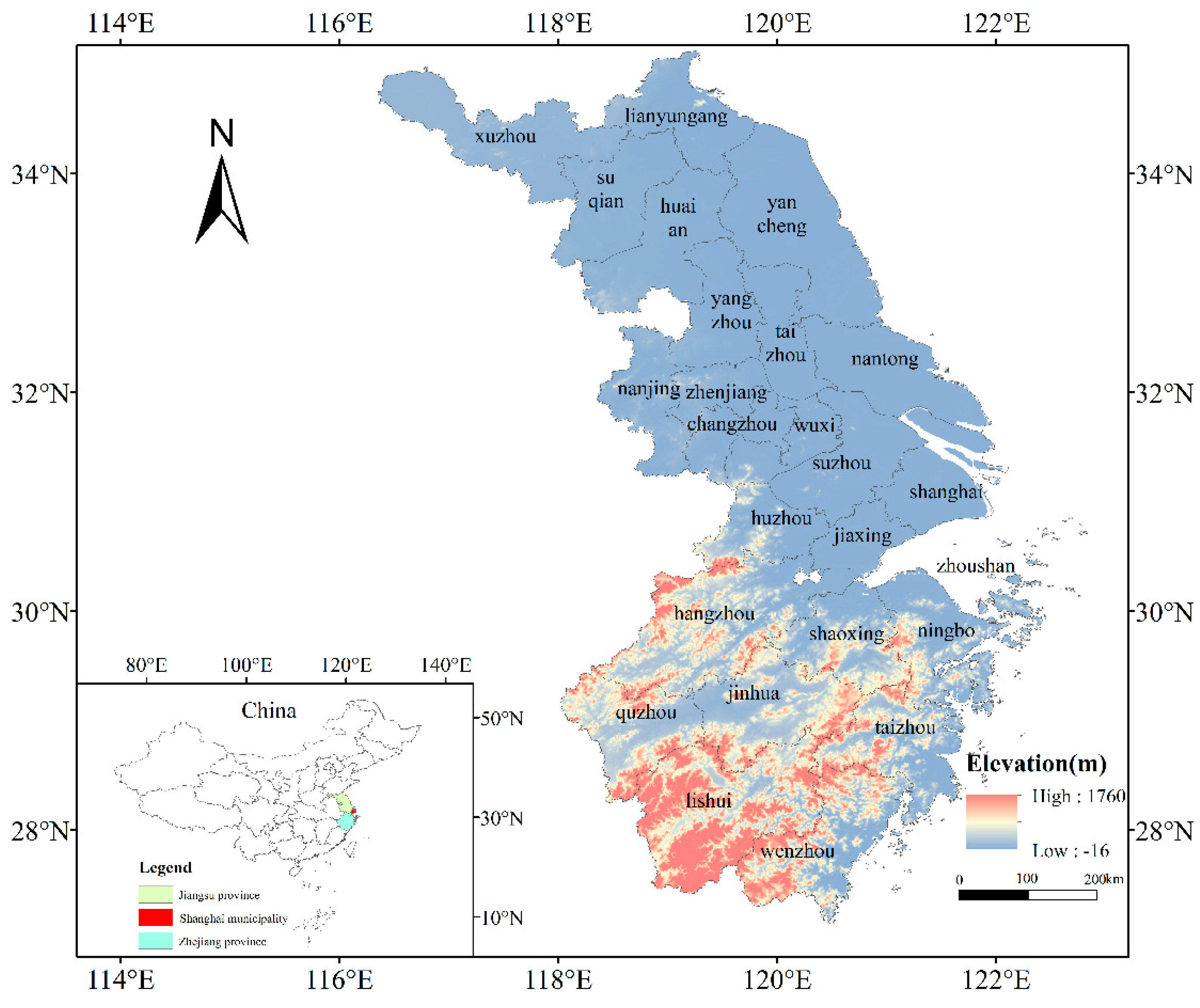


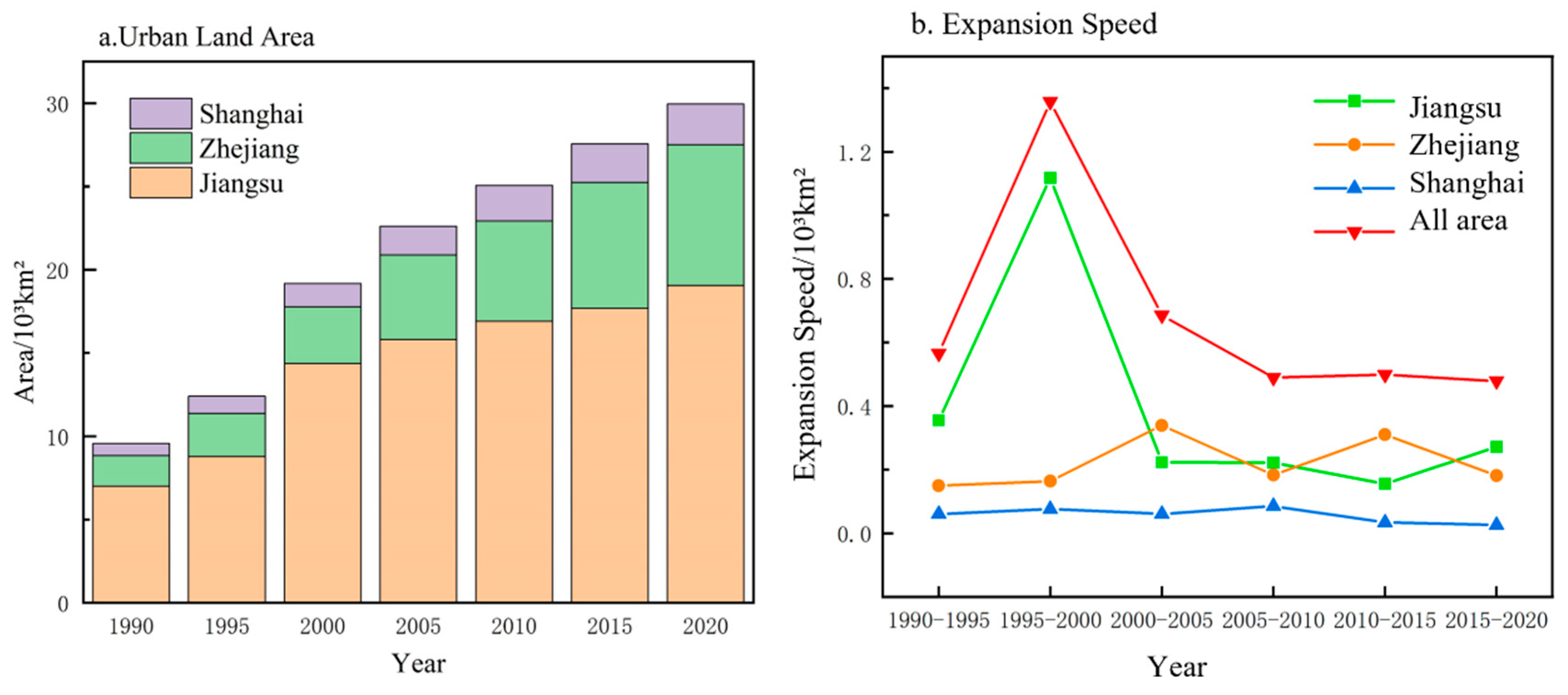
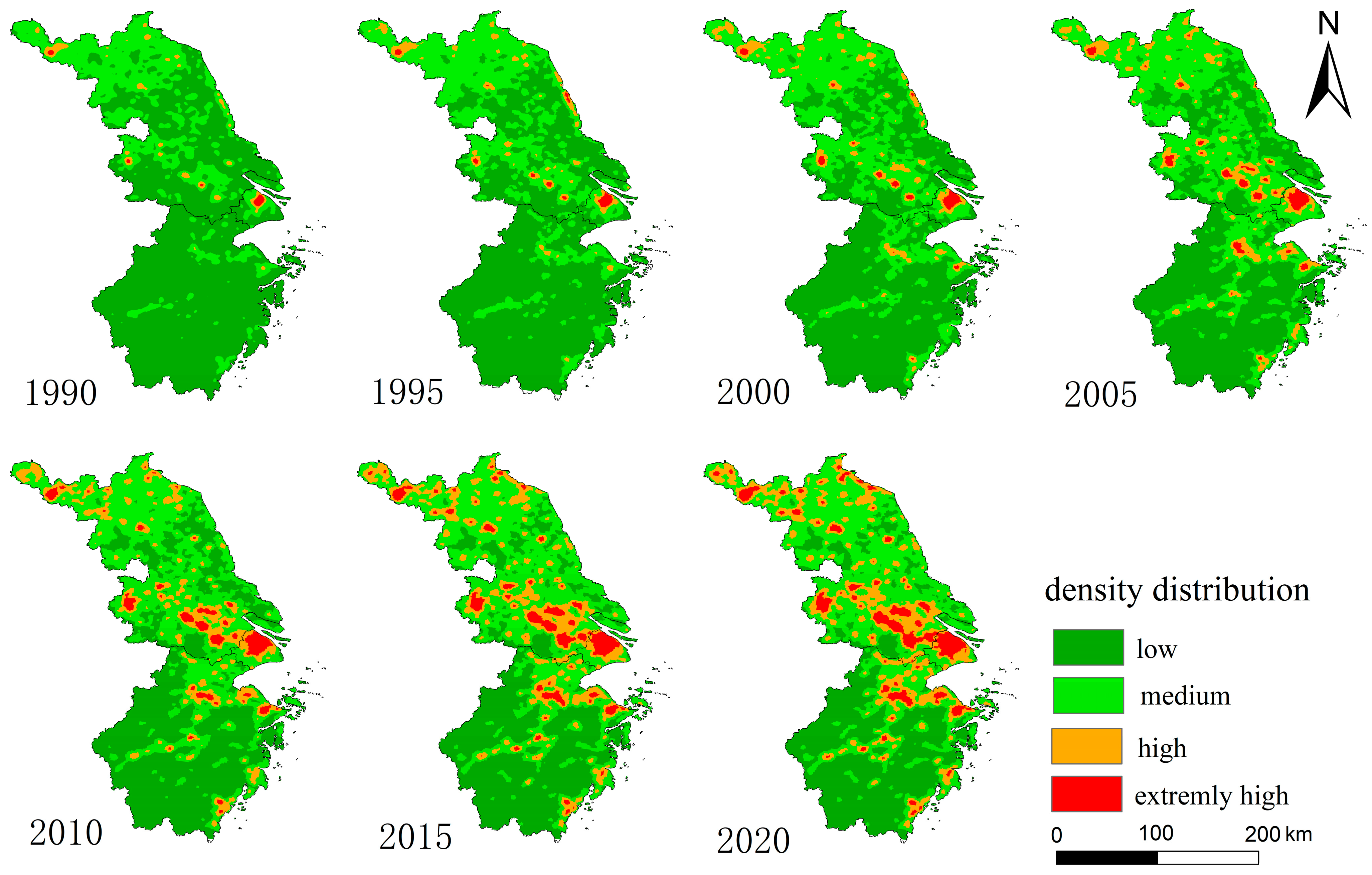
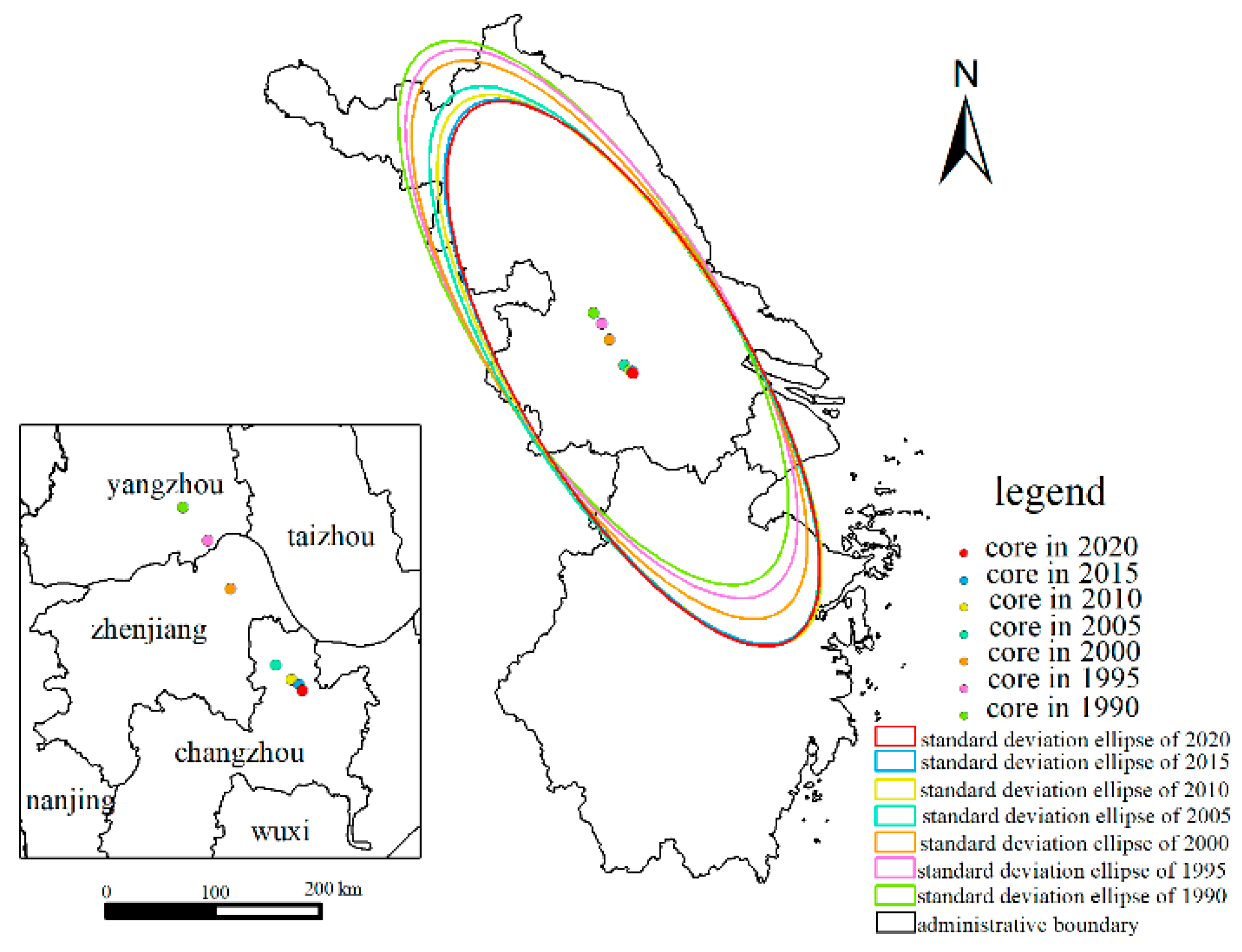
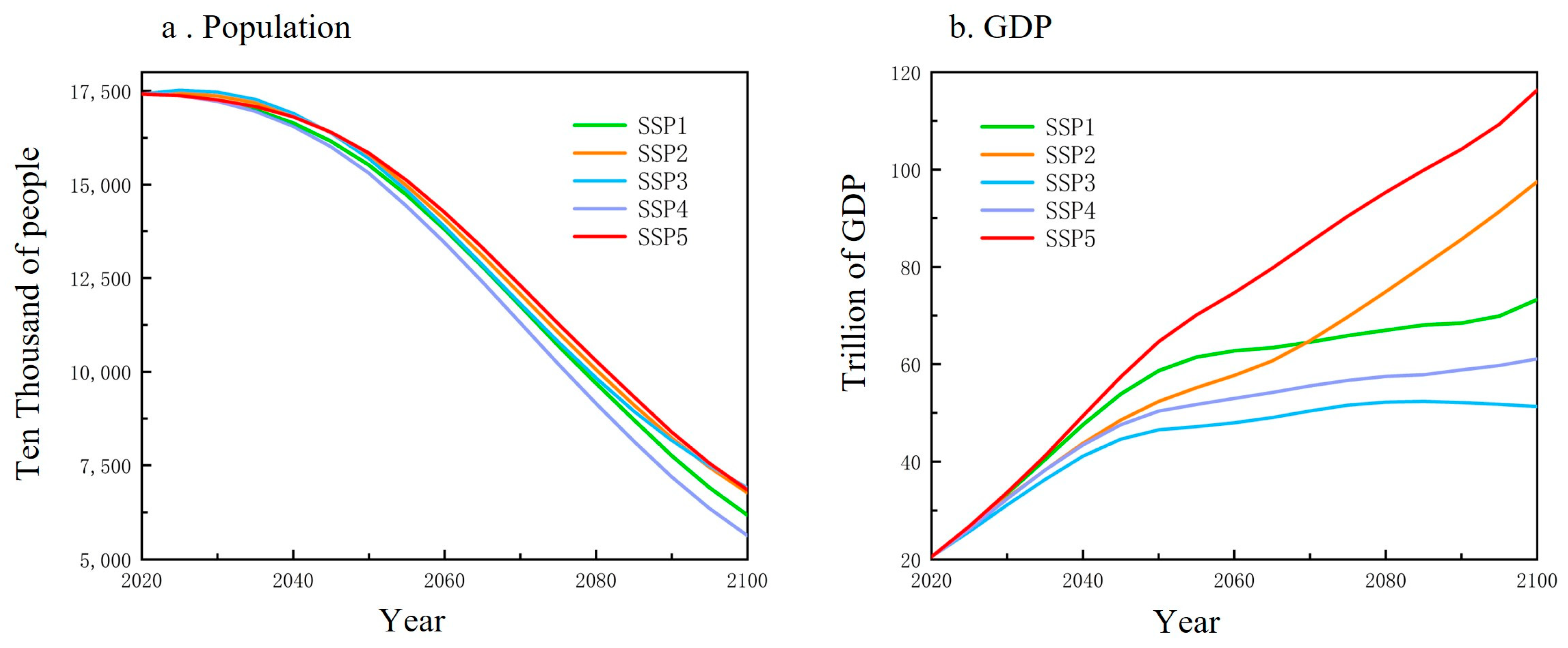
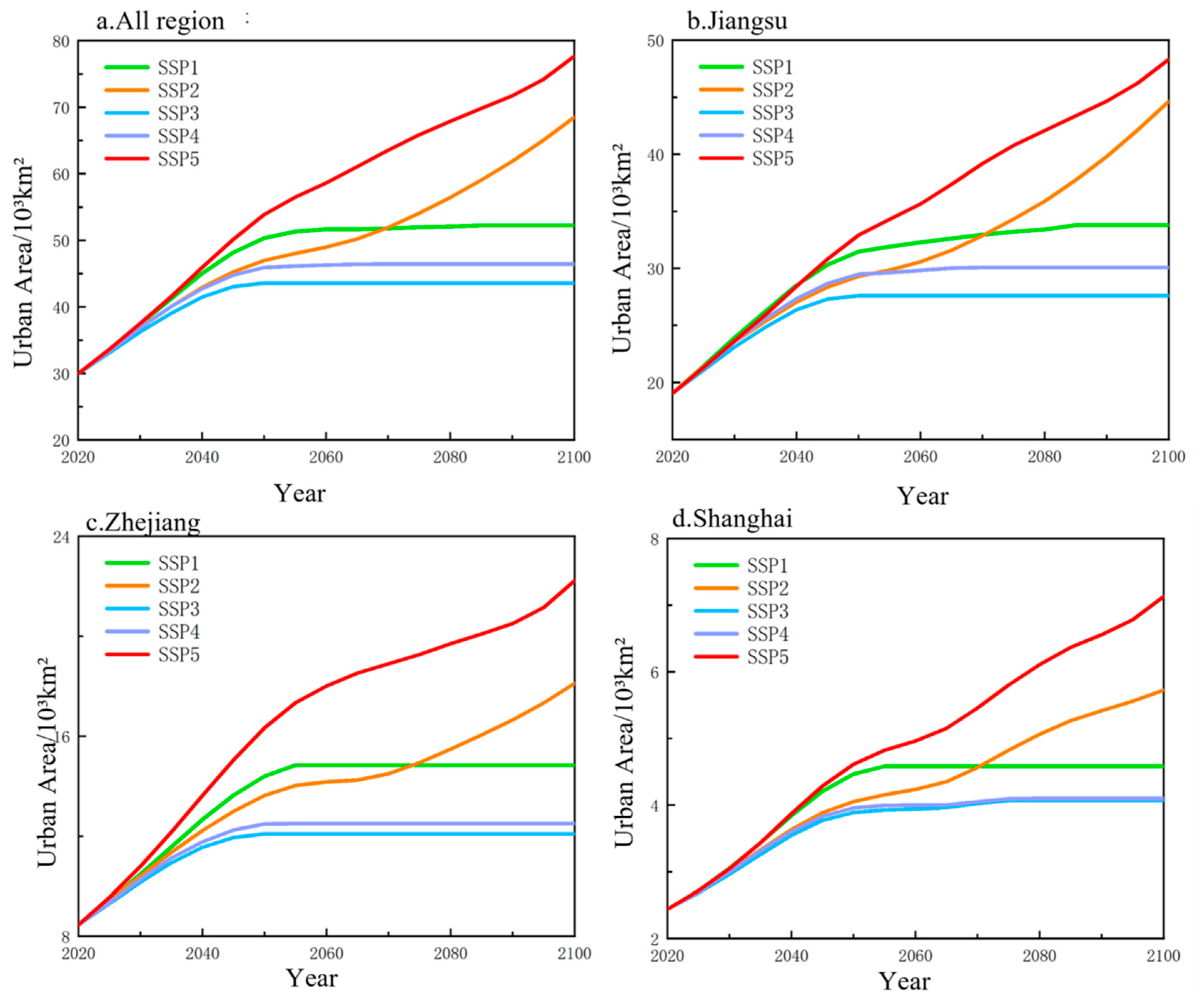
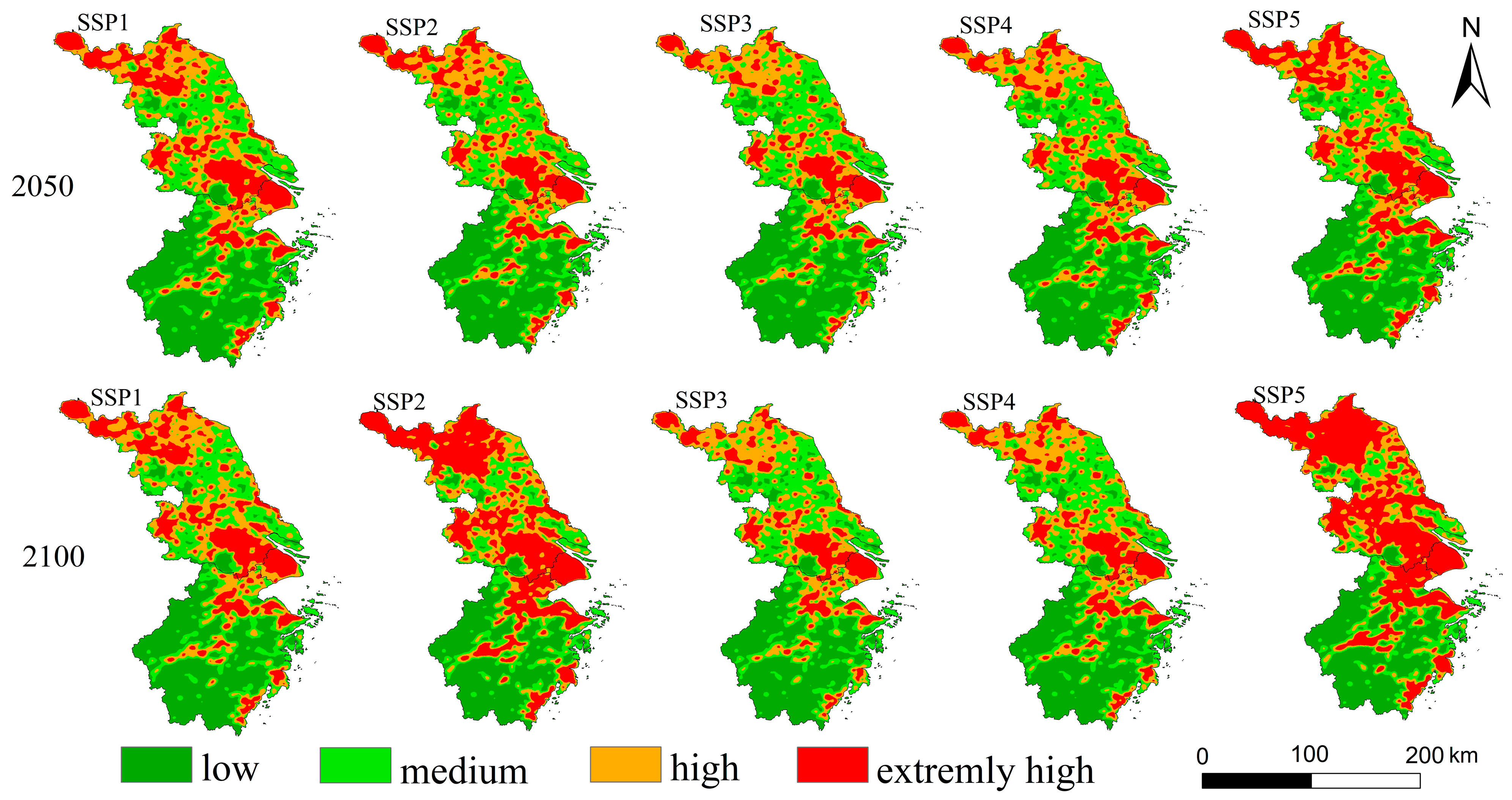
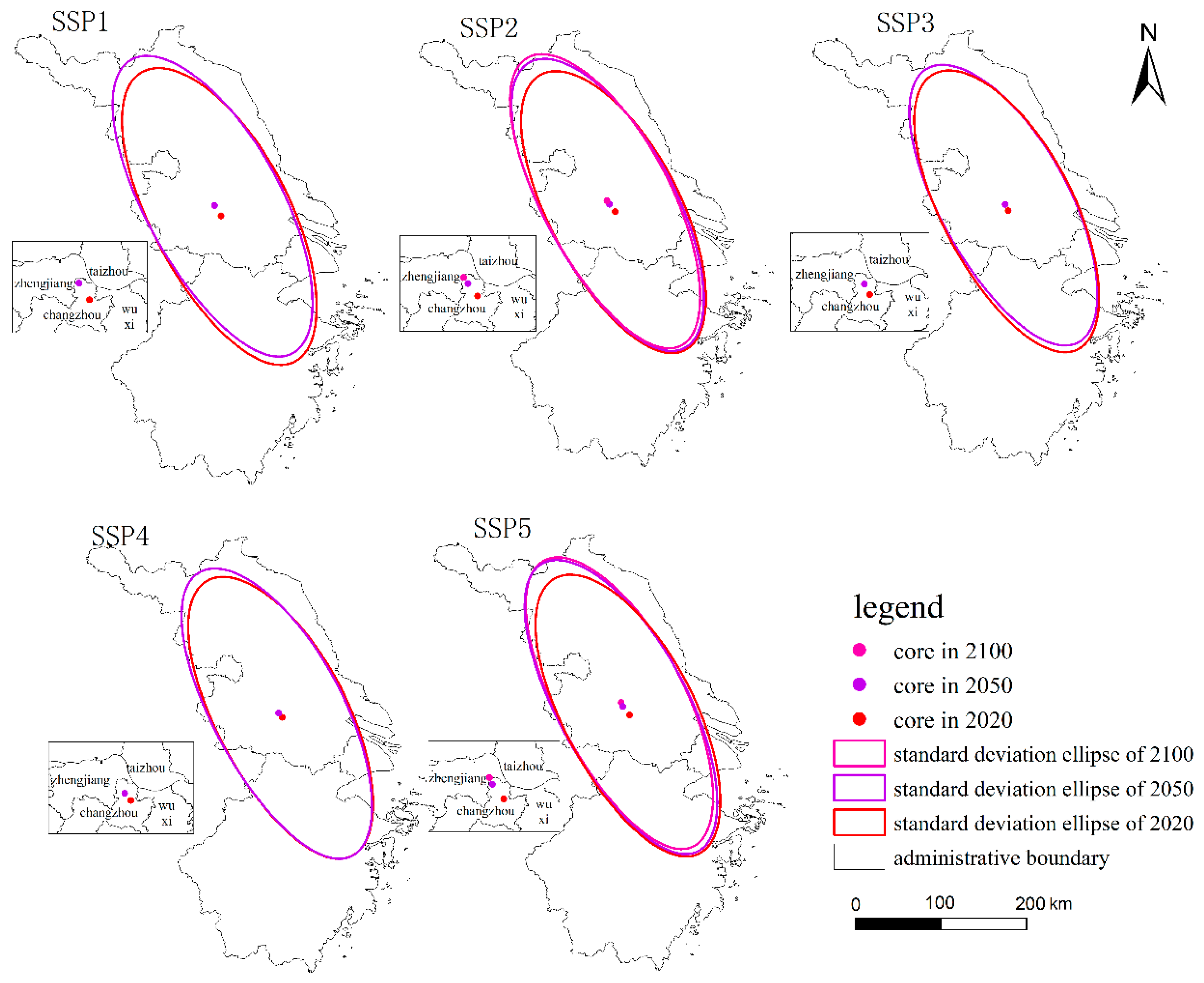
| Type | Name | Source |
|---|---|---|
| Socioeconomic | Primary industry output | https://www.stats.gov.cn/sj/ndsj/, accessed on 8 October 2023 |
| Secondary industry output | https://www.stats.gov.cn/sj/ndsj/, accessed on 8 October 2023 | |
| Tertiary industry output | https://www.stats.gov.cn/sj/ndsj/, accessed on 8 October 2023 | |
| GDP per capita | https://www.stats.gov.cn/sj/ndsj/, accessed on 8 October 2023 | |
| GDP | http://www.resdc.cn/10.12078/2017121102, accessed on 8 October 2023 | |
| Population density | http://www.resdc.cn/10.12078/2017121101, accessed on 8 October 2023 | |
| Topography | DEM | https://www.gscloud.cn/, accessed on 8 October 2023 |
| Slope | Derived from DEM | |
| Aspect | Derived from DEM | |
| Hydrometeorology | Annual mean temperature | http://www.resdc.cn/10.12078/2022082501, accessed on 8 October 2023 |
| Annual precipitation | http://www.resdc.cn/10.12078/2022082501, accessed on 8 October 2023 |
| Definition | Description | ||
|---|---|---|---|
| E | a | low density population-looser growth | Population density is relatively low, with a dispersed population distribution; urban land expansion has not been highly concentrated. |
| b | low density population-compact growth | While the population distribution is dispersed, urban land is concentrated in certain areas through robust planning policies or topographical constraints. | |
| c | high density population-looser growth | Urban land in densely populated areas continues to expand extensively outward. | |
| UG | e | GDP/urban land shrinking | GDP and urban land decline simultaneously; occurs during periods of severe economic recession, population outflow, or post-industrial decline. |
| f | urban land expansion-dominated | Economic output consumes vast amounts of land. | |
| g | GDP-urban land basic coordination | Economic growth and land expansion have largely progressed in tandem; Economic agglomeration benefits have been achieved efficiently without causing excessive land consumption. | |
| h | GDP growth-dominated | Economic growth far outpaces urban land expansion; Economic growth is primarily driven by productivity gains, technological innovation, and others. |
| 1990–1995 | 1995–2000 | 2000–2005 | 2005–2010 | 2010–2015 | 2015–2020 | |
|---|---|---|---|---|---|---|
| Jiangsu | 0.86 | 1.16 | 0.56 | 0.65 | 0.46 | 0.88 |
| Zhejiang | 1.38 | 0.58 | 2.78 | 1.65 | 2.59 | 1.38 |
| Shanghai | 1.39 | 0.67 | 1.21 | 0.29 | 0.79 | 0.65 |
| Expansion Rate (×103 km2/Year) | Expansion Intensity | ||||||||
|---|---|---|---|---|---|---|---|---|---|
| 2020–2030 | 2030–2040 | 2040–2050 | 2050–2100 | 2020–2030 | 2030–2040 | 2040–2050 | 2050–2100 | ||
| SSP1 | Jiangsu | 0.49 | 0.46 | 0.30 | / | 1.02 | 0.95 | 0.88 | / |
| Zhejiang | 0.20 | 0.22 | 0.17 | / | 0.95 | 1.03 | 1.16 | / | |
| Shanghai | 0.06 | 0.08 | 0.06 | / | 1.00 | 1.28 | 1.37 | / | |
| SSP2 | Jiangsu | 0.45 | 0.35 | 0.22 | 0.31 | 1.01 | 0.93 | 0.88 | 1.14 |
| Zhejiang | 0.19 | 0.18 | 0.14 | 0.09 | 0.98 | 1.09 | 1.20 | 0.72 | |
| Shanghai | 0.06 | 0.06 | 0.04 | 0.03 | 1.01 | 1.27 | 1.21 | 0.90 | |
| SSP3 | Jiangsu | 0.41 | 0.33 | 0.12 | / | 1.02 | 0.98 | 0.92 | / |
| Zhejiang | 0.17 | 0.14 | 0.05 | / | 0.95 | 0.95 | 0.91 | / | |
| Shanghai | 0.05 | 0.05 | 0.03 | / | 1.02 | 1.37 | 1.91 | / | |
| SSP4 | Jiangsu | 0.45 | 0.38 | 0.21 | / | 1.03 | 1.00 | 1.04 | / |
| Zhejiang | 0.18 | 0.15 | 0.07 | / | 0.93 | 0.92 | 0.81 | / | |
| Shanghai | 0.06 | 0.06 | 0.04 | / | 0.99 | 1.27 | 1.32 | / | |
| SSP5 | Jiangsu | 0.46 | 0.48 | 0.45 | 0.31 | 0.96 | 0.90 | 0.91 | 1.06 |
| Zhejiang | 0.23 | 0.28 | 0.27 | 0.12 | 1.09 | 1.16 | 1.15 | 0.82 | |
| Shanghai | 0.06 | 0.08 | 0.07 | 0.05 | 0.99 | 1.20 | 1.11 | 1.24 | |
| 1990–1995 | 1995–2000 | 2000–2005 | 2005–2010 | 2010–2015 | 2015–2020 | |||||||
|---|---|---|---|---|---|---|---|---|---|---|---|---|
| E | UG | E | UG | E | UG | E | UG | E | UG | E | UG | |
| Jiangsu | a | h | a | g | a | h | a | h | a | h | a | h |
| Zhejiang | c | g | c | g | c | g | a | g | a | g | b | g |
| Shanghai | c | g | c | g | c | g | c | g | c | h | c | h |
| 2020–2030 | 2030–2040 | 2040–2050 | 2050–2100 | ||||||
|---|---|---|---|---|---|---|---|---|---|
| E | UG | E | UG | E | UG | E | UG | ||
| SSP1 | Jiangsu | a | g | a | g | a | g | / | / |
| Zhejiang | c | g | c | g | a | g | / | / | |
| Shanghai | c | g | c | g | c | g | / | / | |
| SSP2 | Jiangsu | a | g | a | g | a | g | a | g |
| Zhejiang | c | g | c | g | a | g | a | g | |
| Shanghai | c | g | c | g | c | g | a | g | |
| SSP3 | Jiangsu | a | g | a | g | a | g | / | / |
| Zhejiang | c | g | c | g | c | g | / | / | |
| Shanghai | c | g | c | g | c | g | / | / | |
| SSP4 | Jiangsu | a | g | a | g | a | g | / | / |
| Zhejiang | c | g | c | g | a | g | / | / | |
| Shanghai | c | g | c | g | c | g | / | / | |
| SSP5 | Jiangsu | a | g | a | g | a | g | a | g |
| Zhejiang | c | g | c | g | a | g | a | g | |
| Shanghai | c | g | c | g | c | g | a | g | |
Disclaimer/Publisher’s Note: The statements, opinions and data contained in all publications are solely those of the individual author(s) and contributor(s) and not of MDPI and/or the editor(s). MDPI and/or the editor(s) disclaim responsibility for any injury to people or property resulting from any ideas, methods, instructions or products referred to in the content. |
© 2025 by the authors. Licensee MDPI, Basel, Switzerland. This article is an open access article distributed under the terms and conditions of the Creative Commons Attribution (CC BY) license (https://creativecommons.org/licenses/by/4.0/).
Share and Cite
Wu, H.; Su, B.; Jiang, T.; Xu, R.; Dong, Z.; Huang, J. Projections of Urban Land Under the Shared Socioeconomic Pathways—A Case Study of Yangtze River Delta Region. Land 2025, 14, 1995. https://doi.org/10.3390/land14101995
Wu H, Su B, Jiang T, Xu R, Dong Z, Huang J. Projections of Urban Land Under the Shared Socioeconomic Pathways—A Case Study of Yangtze River Delta Region. Land. 2025; 14(10):1995. https://doi.org/10.3390/land14101995
Chicago/Turabian StyleWu, Hailan, Buda Su, Tong Jiang, Runhong Xu, Zhibo Dong, and Jinlong Huang. 2025. "Projections of Urban Land Under the Shared Socioeconomic Pathways—A Case Study of Yangtze River Delta Region" Land 14, no. 10: 1995. https://doi.org/10.3390/land14101995
APA StyleWu, H., Su, B., Jiang, T., Xu, R., Dong, Z., & Huang, J. (2025). Projections of Urban Land Under the Shared Socioeconomic Pathways—A Case Study of Yangtze River Delta Region. Land, 14(10), 1995. https://doi.org/10.3390/land14101995





